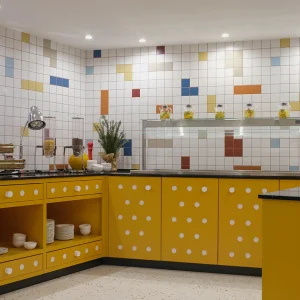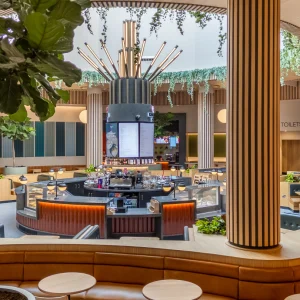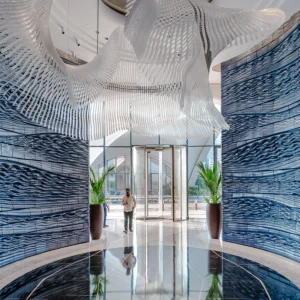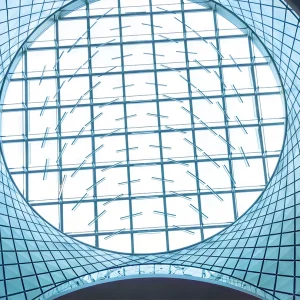
When you’ve met a few lighting designers you tend to notice a pattern emerging. Few of them, back in school or college, had any inkling that they would grow up to work with light. But having fallen into one the design and architecture industry’s youngest and most dynamic professions (it has only fairly recently come to be seen as a discipline in its own right), most lighting designers I’ve met have a passion for what they do that’s almost incandescent. This is true of Mark Ridler, lighting director at architecture practice BDP. He studied engineering at Cambridge before finding his true path as an architectural lighting designer.
‘At school I was good at both art and science,’ says Ridler. 49. ‘But the way the education system worked was that you tended to be channelled into one or the other; I ended up in science. But because I wanted to do something that wasn’t totally theoretical and was applied for some social benefit I went into engineering.’ It was at Cambridge that an interest in theatre drew Ridler towards the world of lighting. So while he diligently completed his degree in engineering, he also taught himself about stage lighting; he dabbled in acting and set design and even went on tour with the university’s Footlights theatre group before spending the next 14 years working in the theatre.

Mark Ridler
Does he look back and think that he was brave to abandon what could have been a very solid career in engineering? ‘I was foolhardy,’ he says, ‘but I’ve always been more motivated by job satisfaction and artistic satisfaction than the safety and security of a prescribed career.’
But eventually, with a growing family, he began to think of looking for something with more stability A one-off job designing a lighting scheme for a friend’s house was the first time he had worked alongside architects, and afterwards Ridler and architects James Wells and Sally Mackereth, of Wells Mackereth, collaborated on a show at the Architectural Association. Soon after he clinched a permanent job at Maurice Brill Lighting Design (MBLD).
‘It’s interesting how in some ways architectural lighting is very similar to theatre lighting and in other ways it’s totally different. Light and the manipulation of it is essentially the same. But in architecture you have to make early decisions and, typically, you’re spending a lot more money. And in theatre, you don’t have to produce content and visualisations.’
One of the his first projects with MBLD was Broadgate Tower and for which the practice won a Lighting Design Award. During his five years at MBLD, Ridler worked on a wide range of projects, including hotels for Hyatt and Wellington House, offices for the likes of PriceWaterhouseCoopers and public spaces that included the Princesshay shopping centre in Exeter.

The recent V&A exhibition Ballgowns: British Glamour from the Fifties, lit by Ridler and BDP Photo credit: Sanna FiSher-payne/ BDP
In 2003, a road accident left him permanently unable to walk, and it was at this point that Ridler met Martin Lupton, who was then leader of BDP lighting, and they clicked. One thing led to another and Lupton offered Ridler a job.
In his 12 years as a lighting designer at BDP, Ridler has seen some major changes in the world of lighting design, he says, both in technology and in people’s attitudes to lighting design as a profession. What have been the biggest technological changes?
‘I know it’s a predictable answer,’ he says, ‘but it’s LED technology that has changed it the most. Because LEDs now are essentially a consumer-led product that has changed everything about the business of lighting design: how it’s specified, how it’s supplied, how it’s designed and how it’s incorporated into projects, as well as the benefits and the challenges that it brings.’
Ridler says he was one of the early adopters of LED technology in architectural lighting design, he uses them increasingly in projects. Even so he’s aware that LEDs, while providing huge benefits in cost and energy savings, are not always the most suitable solution. ‘There are still areas where more traditional lighting technology is still the answer,’ he says. ‘The greatest energy saving on a project comes not from the technology used per se but from using a good lighting designer. By choosing the right lighting levels in the right places at the right times, you can design out a massive amount of energy usage. There is a danger that if architects just design to code and put a blanket level of illumination over an entire area, they might be providing far higher levels of light than needed.’
Ridler is part of the second wave of professional lighting designers and, he says, he owes a debt to the pioneers in the Eighties and Nineties – people like Maurice Brill, Derek Phillips, the designers at LDP, Mark Major and Jonathan Speirs, Michael Phoenix, Graham Large. ‘The next wave after them – of which I’m one – have benefited hugely from the work those people did,’ he says.
Before clients would ask what a lighting designer was; ‘now they might ask whether they need one, but at least many more people are aware of lighting designers as professionals,’ he says. ‘I think that’s also because clients have realised the value of having a lighting designer onboard. They’ve seen spaces that have been worked on by a lighting designer and ones that haven’t: the difference is tangible.’
An early significant and award-winning project with BDP was Princesshay that involved incorporating LEDs into artwork – an innovative and left-field approach to lighting in the public realm. It also set up an important relationship with Land Securities. Ridler also worked on a major office redesign for PriceWaterhouseCoopers. ‘It won a BREEAM Outstanding accreditation and was quite a unconventional approach to office design, involving the use of a lot more domestic and hotel techniques within an office environment,’ he says. He believes that the next big development in lighting design will doing away with light fitting completely. ‘Ultimately nobody wants light fittings because they use up resources, muck up the ceiling, consume energy and cost money. The challenge is how do we deliver that with the minimum of intervention to the architecture or the environment.
‘I think it’s something that continually drives all of the genuine innovations in lighting design and technology. What’s exciting about LEDs, for example, is that they are smaller, use less electricity, are colder and can run on low voltage. That allows you to integrate them into other materials in a much more human-friendly way. They are another step on the path, but they are not the end in itself.’





